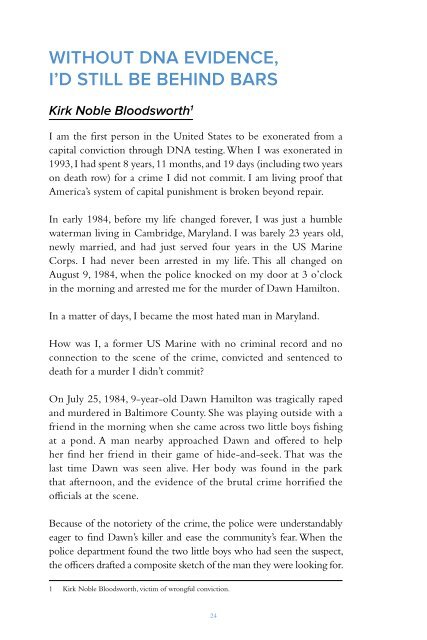PENALTY
DBk0302s7Xm
DBk0302s7Xm
Create successful ePaper yourself
Turn your PDF publications into a flip-book with our unique Google optimized e-Paper software.
WITHOUT DNA EVIDENCE,<br />
I’D STILL BE BEHIND BARS<br />
Kirk Noble Bloodsworth 1<br />
I am the first person in the United States to be exonerated from a<br />
capital conviction through DNA testing. When I was exonerated in<br />
1993, I had spent 8 years, 11 months, and 19 days (including two years<br />
on death row) for a crime I did not commit. I am living proof that<br />
America’s system of capital punishment is broken beyond repair.<br />
In early 1984, before my life changed forever, I was just a humble<br />
waterman living in Cambridge, Maryland. I was barely 23 years old,<br />
newly married, and had just served four years in the US Marine<br />
Corps. I had never been arrested in my life. This all changed on<br />
August 9, 1984, when the police knocked on my door at 3 o’clock<br />
in the morning and arrested me for the murder of Dawn Hamilton.<br />
In a matter of days, I became the most hated man in Maryland.<br />
How was I, a former US Marine with no criminal record and no<br />
connection to the scene of the crime, convicted and sentenced to<br />
death for a murder I didn’t commit?<br />
On July 25, 1984, 9-year-old Dawn Hamilton was tragically raped<br />
and murdered in Baltimore County. She was playing outside with a<br />
friend in the morning when she came across two little boys fishing<br />
at a pond. A man nearby approached Dawn and offered to help<br />
her find her friend in their game of hide-and-seek. That was the<br />
last time Dawn was seen alive. Her body was found in the park<br />
that afternoon, and the evidence of the brutal crime horrified the<br />
officials at the scene.<br />
Because of the notoriety of the crime, the police were understandably<br />
eager to find Dawn’s killer and ease the community’s fear. When the<br />
police department found the two little boys who had seen the suspect,<br />
the officers drafted a composite sketch of the man they were looking for.<br />
1 Kirk Noble Bloodsworth, victim of wrongful conviction.<br />
The witnesses described the suspect as 6 feet 5 inches tall, with a slim<br />
build and dirty blond hair.<br />
At the time of the investigation, I was 6 feet tall, with a thick waist,<br />
fiery red hair and long, noticeable sideburns.<br />
Despite the fact that I did not fit the description, an anonymous<br />
caller suggested my name to the Cambridge Police Department. In<br />
a poorly conducted police line-up, I was identified as the last man to<br />
be seen with the victim.<br />
Eyewitness misidentification is widely recognized as a leading cause<br />
of wrongful convictions in the United States. Since 1989, DNA evidence<br />
has been used to exonerate over 200 individuals, and about 75<br />
per cent of these cases involved inaccurate eyewitness identification.<br />
Other faulty police procedures played a role in my wrongful conviction.<br />
I went to the police station voluntarily. Knowing that I was innocent<br />
of this crime, I wanted to be as cooperative as possible. When I<br />
entered the interview room, a pair of girl’s panties and a rock were<br />
lying on the table. I was never told why. I later found out that the<br />
items were part of an experiment that the police devised because they<br />
believed that the killer would have a strong reaction to these items<br />
related to the crime. I had no reaction. But after I left the station, I<br />
talked to my friends about what the police had done. During the<br />
trial, the police used these statements against me, claiming that I knew<br />
something that only the killer would know. I only knew because they<br />
had shown the items to me that day.<br />
There was no physical evidence against me. I was convicted primarily<br />
on the testimony of five eyewitnesses who were later shown to<br />
be terribly mistaken. With all the fear and anger in the community<br />
surrounding Dawn’s murder, it took the jury less than three hours to<br />
convict. I was sentenced to die in Maryland’s gas chamber. When my<br />
death sentence was announced, the courtroom erupted in applause.<br />
I, an innocent man, was sent to one of the worst prisons in the United<br />
States at the time, the Maryland State Penitentiary. There was not a<br />
24 25


